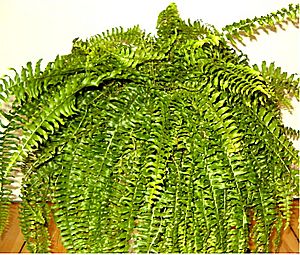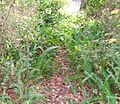Boston sword fern facts for kids
Quick facts for kids Boston sword fern |
|
|---|---|
 |
|
| Conservation status | |
| Scientific classification | |
| Genus: |
Nephrolepis
|
| Species: |
exaltata
|
The Nephrolepis exaltata, also known as the sword fern or Boston fern, is a type of fern. It belongs to the Lomariopsidaceae family. This plant grows naturally in tropical parts of the world.
The Boston fern is an evergreen plant. This means it stays green all year round. It can grow to be about 40 to 90 centimeters (1.3 to 3 feet) tall. Sometimes, it can even reach up to 1.5 meters (5 feet) in height! People also call it the Boston swordfern, wild Boston fern, or fishbone fern.
Contents
What Does the Boston Fern Look Like?
The leaves of the Boston fern are called fronds. These fronds can be very long, from 50 to 250 centimeters (1.6 to 8.2 feet). They are usually 6 to 15 centimeters (2.4 to 5.9 inches) wide. Each frond has many small "leaflets" called pinnae. These pinnae are about 2 to 8 centimeters (0.8 to 3.1 inches) long. They are shaped like small triangles.
The edges of the pinnae look a little bit saw-toothed. This fern can grow in two ways. It can grow in the ground (terrestrially). It can also grow on other plants, like trees. When it grows on other plants, it is called an epiphyte.
Under the ground, the Boston fern has a thin, underground stem called a rhizome. This rhizome can also have small, round parts called tubers. The fern also has small, round spots on its fronds called sori. These sori contain the fern's spores, which are like tiny seeds.
How the Boston Fern Got Its Name
The original Nephrolepis exaltata fern has fronds that stand upright. But a special type, called Nephrolepis exaltata 'Bostoniensis' (the Boston fern), has fronds that arch gracefully. This special type was first found in 1894. It was in a shipment of ferns going from Philadelphia to Boston.
Another story says the name came from a plant nursery owner in Florida, John Soar. He sent these ferns to his friend in Boston.
Where Do Boston Ferns Grow?
The Boston fern is common in wet forests and swamps. You can find it in many tropical places. These include northern South America, Mexico, Central America, Florida, the West Indies, Polynesia, and Africa.
This fern loves places that are moist and shady. It often grows in swamps and areas that flood. Sometimes, it even grows on Sabal palmetto trees.
Growing Boston Ferns at Home
The Boston fern is a very popular house plant. People often grow it in hanging baskets. It is a plant that lives for many years. Even if it looks dead during cold weather, it will grow back in the spring.
Boston ferns like soil that is damp but not too wet. The soil should also have a lot of nutrients. Among common ferns, the Boston fern can handle dry conditions better than most.
These ferns are used to humid places. So, if you grow one indoors, you might need to mist it with water. This is important if the air in your home is dry. Outdoors, the fern prefers some shade or full shade. But indoors, it needs bright, filtered light to grow well.
Most Boston ferns are grown by dividing their rooted runners. These are like small stems that grow along the ground. This is because special types of Boston ferns (cultivars) do not produce true spores. Good news for pet owners: the Boston fern is known to be safe for pets and is not toxic.
Special Types of Boston Ferns (Cultivars)
A cultivar is a type of plant that people have grown specially. Here are some popular types of Boston ferns:
- 'Teddy Junior'
- 'Bostoniensis'
- 'Sonata'
- 'Montana'
- 'Green Lady'
- 'Marissa' (a smaller type)
- 'Todeoides'
- 'Whitmanii Improved'
- 'Rooseveltii'
Some of these ferns have even won awards! The Royal Horticultural Society has given its Award of Garden Merit to:
- Nephrolepis exaltata
- Nephrolepis exaltata 'Bostoniensis'
- Nephrolepis exaltata 'Elegantissima'
Boston Ferns and Clean Air
In 1989, a study by NASA (the space agency) found something cool. The NASA Clean Air Study showed that the Boston fern can help clean the air. It can filter out harmful chemicals like formaldehyde, xylene, and toluene. These chemicals can sometimes be found in homes.
When Boston Ferns Grow Too Much
Sometimes, a plant can grow so much that it takes over an area. When this happens, it is called an invasive species. A fern that looks similar to the Boston fern, called Nephrolepis cordifolia, is a serious invasive plant. It can form thick patches that push out other plants.
In South Africa, the Nephrolepis exaltata is also considered an invasive alien plant. This means it is not native to the area and can cause problems. In some parts of South Africa, people are required by law to remove it. In other areas, you need a special permit to bring, own, grow, or sell this fern. This helps protect the local plants and environment.
Images for kids
See also
 In Spanish: Nephrolepis exaltata para niños
In Spanish: Nephrolepis exaltata para niños









